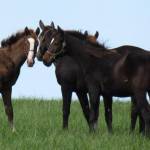Osteochondrosis in Horses

As young horses grow, their skeletons develop and mature through a process in which most of the soft, flexible cartilage is replaced by mineralized bone. Osteochondrosis was initially defined as a disturbance of growing cartilage cells. While this normally proceeds smoothly, in horses with osteochondrosis, the cartilage or growth plates do not mature into bone as normal. Retention of the cartilage can then lead to osteochondritis dissecans or subchondral bone cysts.
The current view is that osteochondrosis may lead to osteochondritis dissecans or subchondral cystic lesions. Bone cysts also sometimes develop secondary to a defect. Osteochondrosis was originally suggested to be a generalized condition, occurring in multiple sites. However, osteochondritis dissecans and lesions may be found in one particular joint, but may not occur elsewhere. Certain biomechanical factors, perhaps including injuries during development, may also be important factors.
Osteochondritis dissecans involves a dissecting lesion with a chondral or osteochondral flap, which may become detached and irritate the joint. Many researchers believe that the release of debris from under the flap causes synovitis and pain, but again, not all cases fit the pattern and there are some instances where the cartilage is intact but the horses still have lameness and synovial effusion.
Subchondral cystic lesions are sometimes seen as a manifestation of osteochondrosis. For example, when a yearling horse has a large subchondral cystic lesion in one stifle and a defect in the other, osteochondrosis is generally assumed to be the cause. However, subchondral cystic lesions may develop following a cartilage surface defect. (These lesions have also been experimentally produced by creating a defect in the subchondral bone.)
Physitis is also known as epiphysitis and physeal dysplasia. In many instances, horses will have pain and swelling at the growth plate without any evidence of retained cartilage. Most cases of physitis do not have any radiographic lesions that are particularly significant, and they often resolve with time.
Angular limb deformities involve excessive deviations in the limbs from side to side. Many angular limb deformities cause no problems and resolve themselves.
Malformation of the small bones within carpus or hock joints represents a delay in endochondral ossification, usually as a result of prematurity or a delay of ossification caused by hypothyroidism. The cuboidal bones can collapse because of insufficient ossification. Veterinarians treat, and can sometimes prevent, this condition by casting the affected leg.








